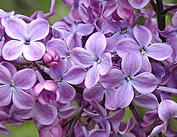| Two New Lilacs from the U.S. National Arboretum |

|
The 446-acre arboretum maintains and displays many of the ornamentals and flowering trees, shrubs and herbaceous garden plants found in cities, towns and home landscapes throughout the United States. To these traditional favorites, researchers there and in the ARS Floral and Nursery Research Unit in Washington, have added many of the superior new floral and woody nursery plants now seen in public areas, as well as in private gardens. 'Old Glory' and 'Declaration' are two new Syringa cultivars developed in the arboretum's shrub-breeding program. Bred and initially selected by the late USNA horticulturalist Donald Egolf and released by geneticist Margaret Pooler, they follow the release of the 'Betsy Ross' lilac in 2000. 'Old Glory' and 'Declaration' are each suited to a variety of landscape uses, including as background plantings in shrub borders, as deciduous hedges, or for mass-plantings in larger areas. 'Old Glory' was selected for its abundant fragrant, bluish-purple flowers, rounded growth habit and disease-tolerant foliage. In 25 years of testing in Washington, it grew nearly 11.5 feet high and a little over 13 feet wide. Compared to other Syringa x hyacinthiflora types of lilac, 'Old Glory' has shown good field tolerance to Cercospora blight and Pseudomonas syringae in warmer climates where these diseases are a problem. It has also shown better-than-average tolerance to powdery mildew. 'Declaration' was selected for its fragrant, dark-reddish-purple flowers, nearly foot-long flower clusters and open, upright growth habit. In 25 years of testing at the arboretum, it grew 8.5 feet high and about 6.5 feet wide and also is well suited to a variety of landscape uses. However, it is recommended primarily for traditional, cooler lilac-growing regions. Both 'Old Glory' and 'Declaration' bloom in mid- to late April at the arboretum, which is located in Plant Hardiness Zone 7a and has an average minimum temperature range of 5 to 0 degrees Fahrenheit. Planting stock should be available from a limited number of nurseries in 2006, and should be available from retailers in 2008. 

May 12, 2006 -- Two of the newest additions to an ever-growing list of original ornamental plants produced by breeders with the U.S. National Arboretum (USNA), Washington, D.C., are lilac cultivars named 'Old Glory' and 'Declaration.' They were recently released to the public by the arboretum, administered by the Agricultural Research Service (ARS), the U.S. Department of Agriculture's chief scientific research agency.
